Sir Mark Sheldon KBE
13 November 1871 - 13 October 1956
Businessman and philanthropist
Sir Mark Sheldon, noted philanthropist and financier, was regarded as one of Australia’s leading banking and commercial figures in the early decades of the twentieth century, representing Australia abroad on a number of occasions.
Image: Sir Mark Sheldon returning to Sydney on the TSS Maunganui, 14 May 1930. National Library of Australia, Fairfax Archive, No 3199. NLA.pic-vn6220126. Reproduced with permission of the Fairfax Archive.
Plaque location
9 Ginahgulla Road, Bellevue Hill
View all plaques in Bellevue Hill
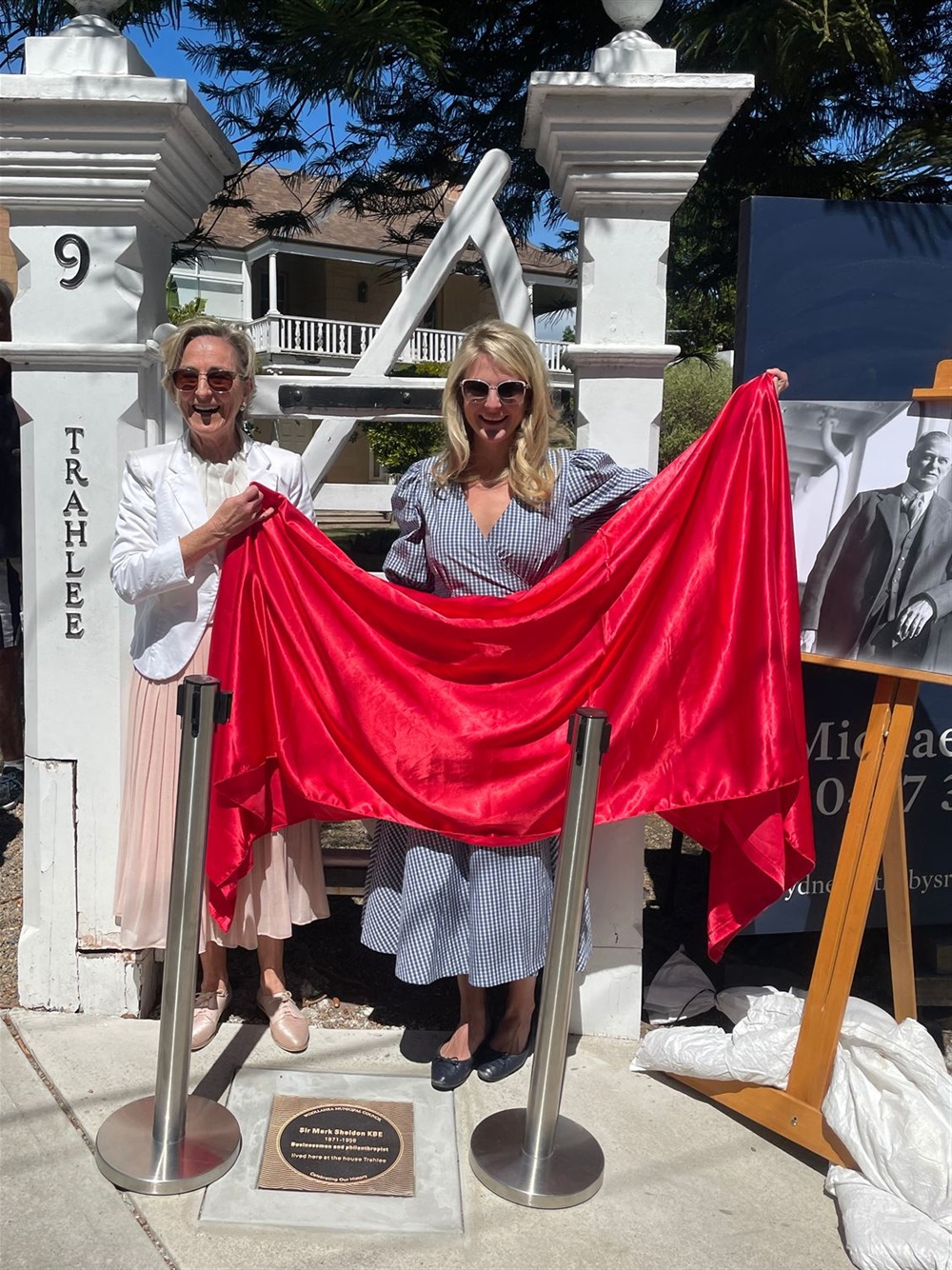
Plaque unveiling for Sir Mark Sheldon at 'Trahlee', 9 Ginahgulla Road, Bellevue Hill, 6 October 2023. Plaque nominator and great granddaughter Gabrielle Gollan with Woollahra Deputy Mayor Cr Sarah Swan.
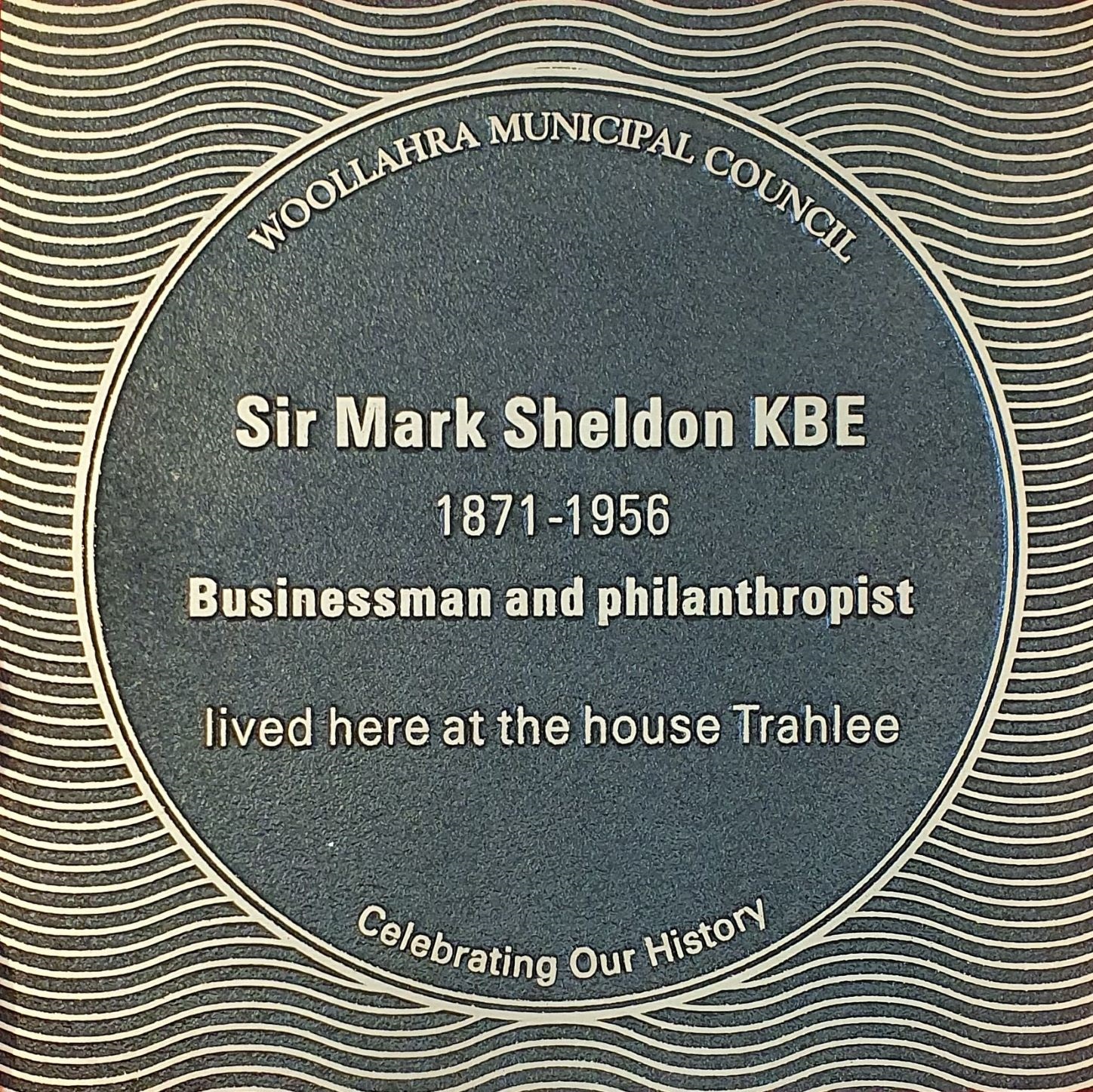
On 6 October, 2023 a plaque to commemorate the life and career of Sir Mark Sheldon KBE was unveiled at 'Trahlee', 9 Ginahgulla Road, Bellevue Hill, his home from 1905-1956.
Gallery
Mark Sheldon, born on 13 November 1871 at Armidale, New South Wales, was the eldest of six children of William Sheldon, a medical practitioner, and his wife Anna Theresa, nee White.
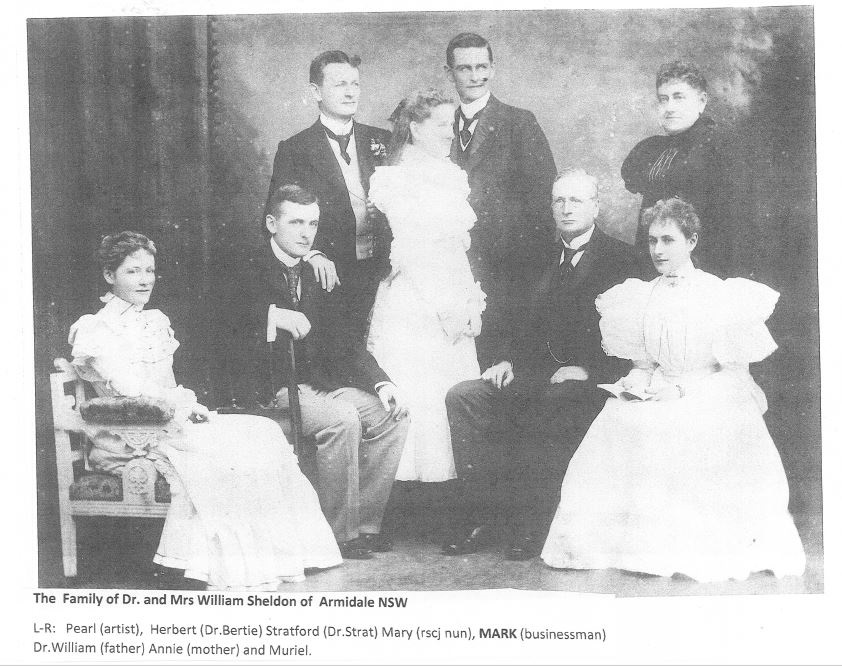
Image from a Private Collection.
As a child Mark was educated at Armidale Public School before coming to Sydney, aged 8, as a boarder at St Ignatius’ College Riverview, an intrepid journey made on horseback, where he was one of the first students to attend the school in 1880, the year it was established.
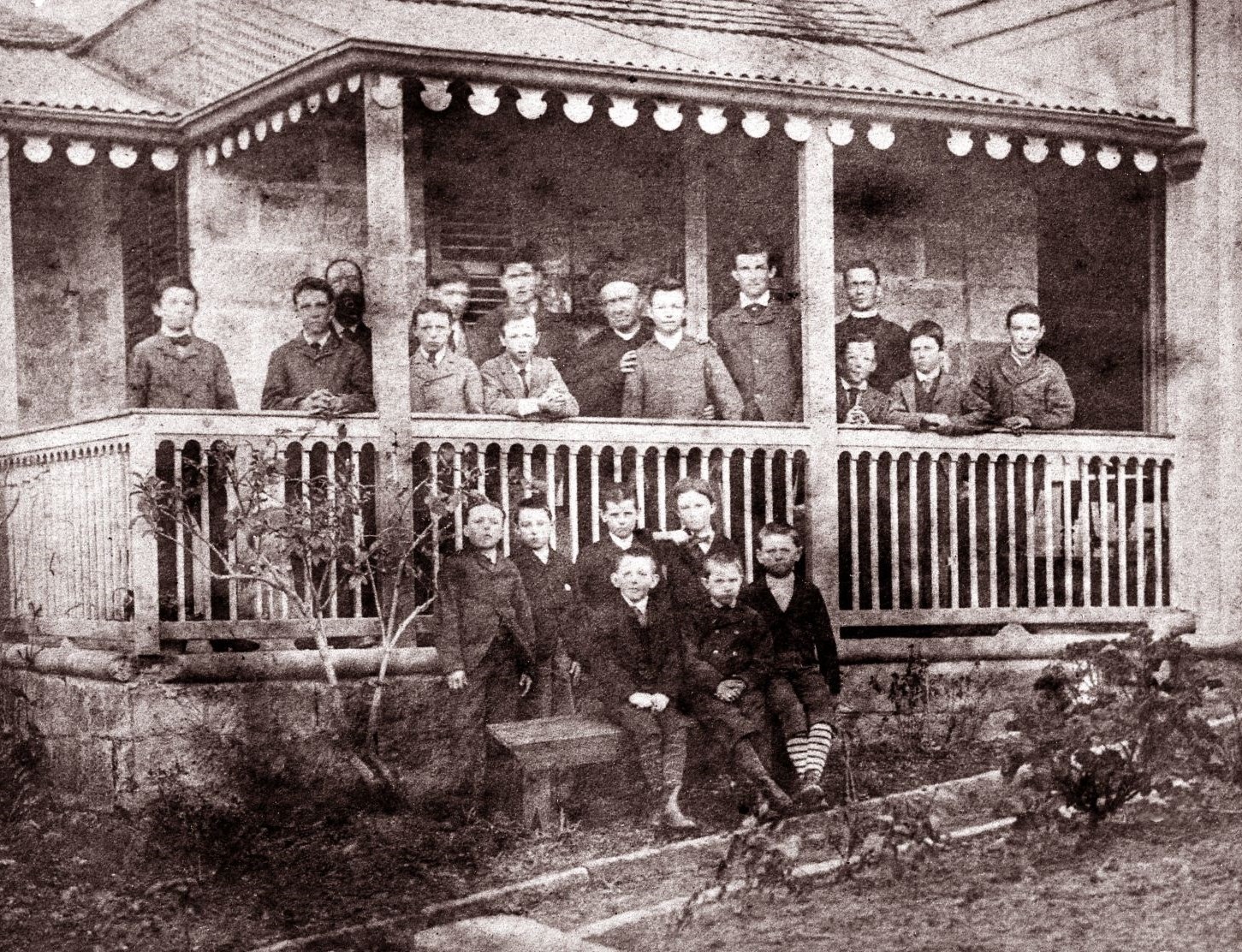
Mark Sheldon (front row, far right) aged 8 on the verandah of Riverview cottage in 1880 with Fr Dalton SJ, staff and students, wearing striped socks. Source: Jubilee Book 1880-1930 pages 8-9, St Ignatius' College Riverview. Image courtesy of St Ignatius' College Riverview Archives.
He later reminisced, at the occasion of the St Ignatius’ Jubilee in 1930, that in order to travel to Riverview from Armidale he needed to ‘ride from Armidale to Tamworth, and ride anything that came along in the way of change of horses, sometimes by way of a change I travelled by Cobb and Co’s coach’1. In his first year there were only a handful of students and ‘the only building at that time was the stone cottage: that building comprised the whole school. Two other boys and I slept in the room in front of the west side’.2
'Riverview at its Origin', Mark Sheldon. St Ignatius' College Riverview - Jubilee Book 1880-1920 pp 8-9(PDF, 4MB) [from St Ignatius' College Riverview Archives].
Opening in February 1880, the College was established by the Jesuits of the Society of Jesus as a boarding school for boys aged between 8 and 12 years. Mark Sheldon spent four years at Riverview leaving just before his twelfth birthday at the end of 1883 to continue his secondary studies in England at Ushaw College, in Durham.3 He received an ‘honourable mention’ for Rudiments in his honours examinations at Ushaw in 1888.4 Records show that Mark completed the University of Sydney Matriculation Examination in 1890.5
In 1890, Mark Sheldon joined the firm of Dalton Brothers - merchants and shipping agents - as a junior, rising to the position of General Manager by 1896. In the 1850’s Dalton Bros. established a business at Orange, N.S.W., becoming the largest wholesale distributor in rural districts west of the Blue Mountains.6 As part of the expansion of their business enterprises a large sandstone warehouse for imports, designed by Benjamin Backhouse, was completed at 115 Pitt Street, Sydney by 1879.7
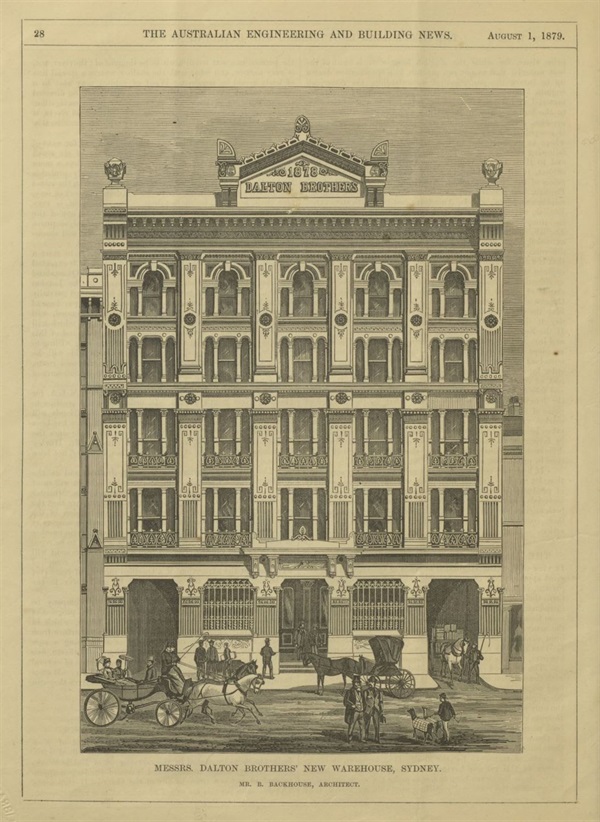
'Messrs. Dalton Brothers' new warehouse, Sydney. Mr B Backhouse Architect'. Warehouse at 115 Pitt Street, Sydney. Source: The Australian engineering and business news No. 2, 1 August 1879.
In 1897, Sheldon married Blanche Mary Dalton, daughter of his employer, Thomas Dalton. Following the death of his father-in-law in 1901, the firm became a limited company, and Sheldon became managing director, a position he held from 1902 until his death in 1956.
From this time Sheldon's business interests increased widely, and he took on various public appointments.
Economic conditions towards the end of WW1 had led the government of the day to consider the future of overseas export markets and commercial representation abroad. Henry Braddon (later Sir Henry) of the established pastoral company Dalgety & Co, was appointed ‘commissioner’ to the USA in September 1918 to deal with trade matters. Braddon served for less than a year and in August 1919 was succeeded by Mark Sheldon, who took up the position as the second Commonwealth [Australian] Trade Commissioner to the United States.
Considered a prestigious appointment, Sheldon's role was ‘to develop trade between Australia and the United States, publicise and provide information about Australia, take responsibility for the Commonwealth’s business interests in the United States and furnish reports at regular intervals’.8 In a farewell at a Sydney Chamber of Commerce luncheon, speakers noted that Mr Mark Sheldon had a ‘markedly successful business career’ and was thought to be well qualified for the role with qualities of ‘a diplomat, financier, merchant, manufacturer and logician.’9
![Sir Mark Sheldon [caricature].Daily Telegraph 6 May 1926 p 7.](/files/assets/public/v/1/library/plaques/sir-mark-sheldon/sir-mark-sheldon-caricature-daily-telegraph-6-may-1926-p-7.jpg?w=527&h=860)

Sir Mark Sheldon (1926, May 6). The Daily Telegraph p. 7.
Sheldon spent three years in the United States, travelling widely to promote Australia and trade opportunities between the two countries and engaging with trade associations and representatives. In September 1922 he was one of the Australian delegates to the League of Nations convention in Geneva, where he was prominent in debate, in particular concerning disarmament. He returned to Sydney in January 1923. In March 1925 he travelled to England representing Australia on the Imperial Economic Committee.
At home, Sheldon was prominent in business circles and a member of the Council of the Commonwealth Bureau of Commerce and Industry as well as President of the Sydney Chamber of Commerce and the Associated Chambers of Commerce of Australia. He also chaired the Repatriation Board of New South Wales (1917-19).
Mark Sheldon held a number of board positions, notably as chairman of Waterloo Glass Bottle Works Ltd (1910-15), as a director of the Australian Bank of Commerce (Chairman 1915-31) and a State executive member of the British Red Cross Society.
A long-time director of the Australian Bank of Commerce, Sir Mark was re-elected as Chairman of directors of the bank in 1922. A report on his appointment noted ‘the able manner in which he carried on the work in America’, his commanding appearance (he was 6 ft 1½ in), and his ‘courtesy and geniality, intermingled with sound business acumen and a propensity for finance’.
The high opinion his commercial friends had formed of him was amply justified by the able manner in which he carried on the work in America, so adequately commenced by Sir Henry Braddon. Of commanding appearance, Mr Sheldon is a quiet but firmly effective speaker. Courtesy and geniality are traits of his character that have won for him a large circle of friends. Intermingled with those qualities are sound business acumen and a propensity for finance that have carried him to the head of one of our large financial institutions10.
He was also chairman of the Distributors' Co-operative Co. of New South Wales in the 1920s, chairman of Tooheys Ltd from 1930-1940 and chairman of Anthony Hordern & Sons Ltd from 1926-40. In 1935 he was included by Rydge's in a series on 'Men who control Australian business'.
With great foresight, Sheldon strongly advocated for the adoption of the metric system in 1929, saying that he was ‘more convinced than ever that the sooner the decimal system in weights and money was introduced to Australia, the better’.11 It was a proposition that was not realised for almost four decades, when the metric system was introduced.
Awards
Mark Sheldon was appointed Knight Bachelor (Imperial)12 on 3 June 1922 and awarded the Order of the British Empire, Knight Commander (Civil) (Imperial) two years later on 3 June 1924.13 Both awards were for ‘Services to the Commonwealth’.
Sir Mark and Lady Sheldon were prominent figures in the Catholic community. At an investiture of papal honours held at St Mary’s Cathedral in May 1929 Sir Mark was honoured as Knight Commander of the Order of St Gregory the Great for services to the Catholic Church. At the same time Lady Sheldon, noted as ‘a most generous contributor to the Catholic Church’ received the papal honour of Dame of the Order of the Holy Sepulchre.14
Mark Sheldon married Blanche Mary Dalton at St Mary’s Church, North Sydney, on 26 October 1897. Following the service a reception was held in the grounds of the Dalton’s family home Wheatleigh in Willoughby. The couple initially settled at ‘St Ronan’s’ in Neutral Bay. They had three daughters, Mary Lillian (b. 1898), Dorothea Mary (b. 1901) and Marcella Mary (b. 1903), and two sons, Thomas Cuthbert (b. 1907) and Marcus W.J. (b. 1909). The three girls attended school locally at the Convent of the Sacred Heart (Kincoppal-Rose Bay School) while the boys were sent to Downside School in Somerset, England.
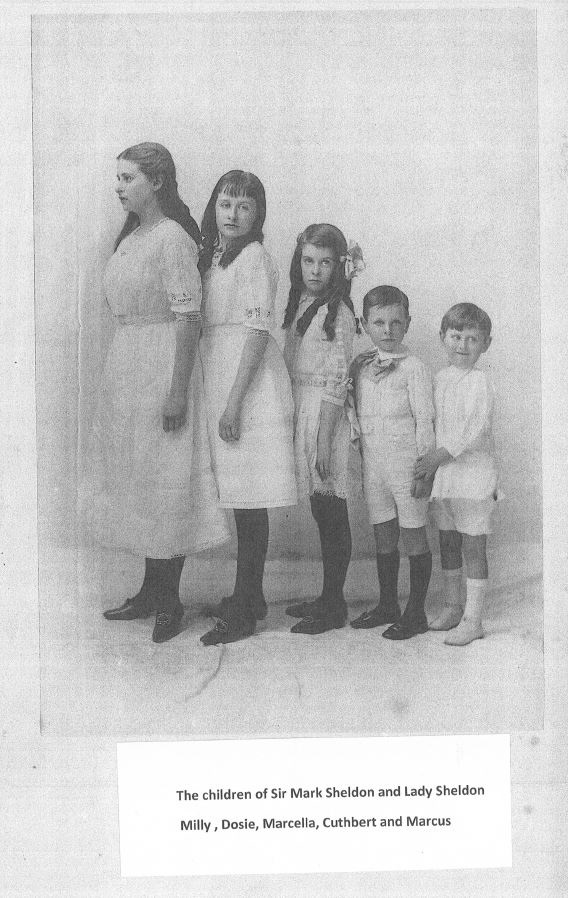
Image from a Private Collection.
Trahlee, 9 Ginahgulla Road, Bellevue Hill
In 1905 Blanche and Mark Sheldon purchased the property Trahlee, a large stone house situated on over 5 acres of grounds in Bellevue Hill at the corner of Kambala and Ginahgulla Roads. Trahlee remained the family home until their deaths in the 1950s.
Trahlee appears to have been built during the 1860s after a 99 year lease of 5 acres 4 perches of the Point Piper Estate was taken up by Lancelot Edward Threlkeld on 1 January 1858.15 Threlkeld transferred the leasehold to Sir James Reading Fairfax in 1866 and he and his family were living at Trahlee by the end of the decade.16 James’s father John Fairfax lived at nearby Ginahgulla and after his death in June 1877 James offered Trahlee for sale as ‘that first-class, highly-finished, commodious family mansion … together with 5 acres of highly improved ornamental grounds’ before himself moving to Ginahgulla.17
By 1878 the leasehold to the property had been transferred to Joseph Thompson, ‘Capitalist of Trahlee, Belle Vue Hill’, who was elected in 1881 as an alderman of Woollahra Council representing the Bellevue Ward.18
After the property was transferred in 1902 to John Thomson Brown, freehold was obtained before being transferred to Mark and Blanche Sheldon. In 1927 and again in 1934 the Sheldon’s subdivided the property creating nine allotments along Fairfax Road and reducing Trahlee’s curtilage to about 3¼ acres. An earlier subdivision plan of the property proposed in 1919, shows a footprint of the house with outbuildings, a tennis court, and garden with retaining walls and steps, fences, a sprinkler, bamboos and a pepper tree.19
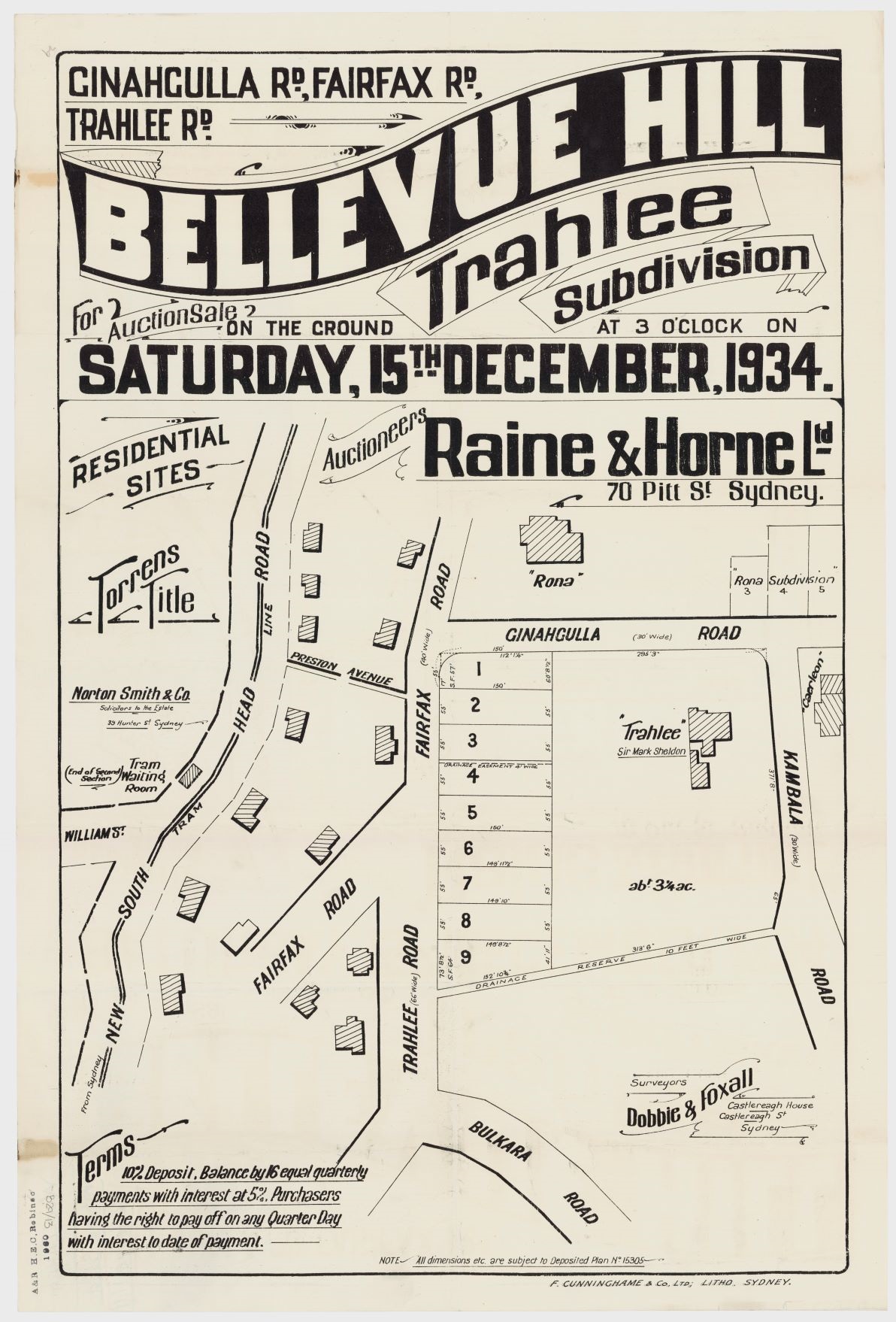
'Bellevue Hill Trahlee Subdivision' Auction Saturday 15th December 1934 SLNSW FL10410199.
In March 1956, following the death of Lady Sheldon, the contents of Trahlee were offered for sale and later that year the property was subdivided into 17 allotments with the house remaining on 4 lots. A new cul-de-sac was created for the subdivision and in November 1956 Woollahra Council resolved to adopt the name ‘Sheldon Place’ in honour of Sir Mark. As a condition of the subdivision one allotment at the end of the cul-de-sac was dedicated to Council for use as a reserve.
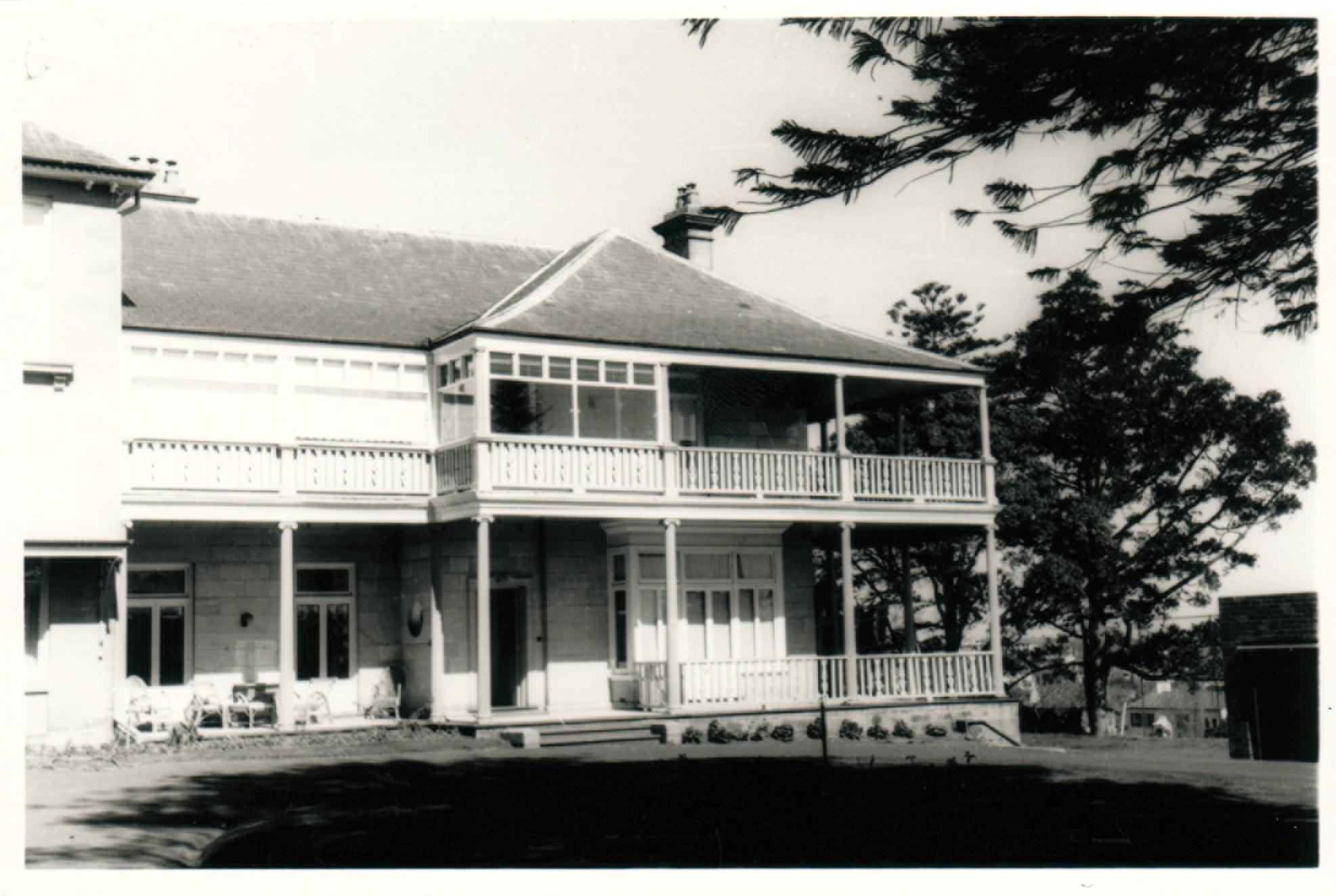
Trahlee was later converted to flats and is a heritage listed item on the Woollahra Local Environmental Plan 2014.20
Sir Mark and Lady Sheldon were generous benefactors to various charities, organisations and institutions showing a particular interest in educational and medical causes. Sir Mark was a firm believer in the importance of education and the opportunities for advancement that a good education could provide. He showed a continuing commitment to education, being a participant in the life of St Ignatius’ College as an ‘old boy’, serving as President of the St Ignatius’ College ‘Old Ignatians’ Union’.21 Sir Mark donated to the University of Sydney as well as serving on its Appointments Board from 1923 and on the executive committee for a major fund raising appeal for the University in 1927. In 1930 he arranged for the visiting Australian Cricket team whilst in England to stay at his sons’ old school Downside where he had also donated a cricket pavilion.22
The Sheldon’s gave on-going support to the Convent of the Sacred Heart, Rose Bay, where Lady Sheldon, her three daughters and Sir Mark’s sisters were all educated, and Sancta Sophia College at the University of Sydney. A large donation from Lady Sheldon facilitated the building of a swimming pool at the School in 1934-35 23, while another generous donation from her enabled the opening of the Sheldon Wing at the Sancta Sophia College in 1928.
Sir Mark was instrumental in bringing the Bill of Incorporation before Parliament in 192924, which established Sancta Sophia, a residential women’s college as a college of the University of Sydney. Sir Mark and Lady Sheldon were both elected members of the first Council of the College in 1930, with Sir Mark serving on the Council until 1955. Lady Sheldon continued her support of the College with the establishment in 1948 of three scholarships (named after the Sheldon’s daughters) for students of Rose Bay Convent to reside at Sancta Sophia’s.
Among other beneficiaries of the Sheldon’s generosity were the Royal Australasian College of Physicians, Lewisham Hospital, Aquinas College, Adelaide and St John of God Hospital, Richmond.
In the Afterword to 'Emissaries of trade: a history of the Australian trade commissioner service' published in 2008, then CEO of Austrade Peter O’Byrne, remarked that ‘there is a sense of adventure in the way in which Australia’s trade commissioners sought out new markets and opportunities for the nation’s exports. To engage in this sometimes hazardous pursuit they were people of great character with flair, initiative and dynamism’ – traits that could aptly be applied to Sir Mark Sheldon.
Sir Mark Sheldon is remembered for the significant contribution he made to business and financial affairs within Australia, to international trade relations, and as a constant and generous supporter, notably to women’s education.
Lady Sheldon died on 22 July 1955 aged 82 years and was buried at South Head Cemetery. The following year on 13th October, 1956, Sir Mark Sheldon died aged 84 at Lewisham Private Hospital. He too was buried at South Head Cemetery after a requiem Mass at St Mary's Cathedral.25 26
Australian Dictionary of Biography
Births Deaths and Marriages NSW
Emissaries of trade: a history of the Australian trade commissioner service
Historic Land Registry Services
Griffiths, G. Nesta, Some people and houses of NSW, Ure Smith, 1949
NLA Trove Database
Sands Sydney Directory
Schedvin, Boris, ‘Emissaries of trade: a history of the Australian trade commissioner service’, Barton, A.C.T., Dept. of Foreign Affairs and Trade, 2008
Woollahra Council archives – building registers; rate and assessment books; minute books; subdivision plans
Ginahgulla Road, Bellevue Hill, No. 9, ‘Trahlee’. Woollahra Libraries Local History Research File
Sheldon Place Reserve (David Joel Reserve), Bellevue Hill. Woollahra Libraries Local History Research File
Footnotes
1 ‘Riverview at its origin’, Jubilee Book: St Ignatius’ College, Riverview, 1880-1930, [1930], p. 8
2 ‘The Spirit of Riverview: a golden jubilee’, Freeman’s Journal (Sydney: N.S.W. 1850-1932), 28 Aug 1930, p.22 https://trove.nla.gov.au/newspaper/article/128797631
3 ‘Birthday Honours’, The Daily Telegraph (Sydney, N.S.W. : 1883-1930), 3 Jun 1922, p. 6 https://trove.nla.gov.au/newspaper/article/245725470
4 ‘Exhibition week at Ushaw College’, Tablet, 11 Aug 1888, p.22 https://www.britishnewspaperarchive.co.uk/viewer/bl/0002447/18880811/055/0022
5 Ibid and Calendar of the University of Sydney for the year 1890, Matriculation Examination, p.255 https://calendararchive.usyd.edu.au/Calendar/1890/1890.pdf. The Matriculation Register has ‘Private Studies’ recorded against his name rather than the name of a school.(Source: University of Sydney Archivist).
6 Martha Rutledge, 'Dalton, James (1834–1919)', Australian Dictionary of Biography, National Centre of Biography, Australian National University, https://adb.anu.edu.au/biography/dalton-james-284/text5061
7 Commercial architecture, Illustrated Sydney News and NSW Agriculturalist and Grazier, 12 Jul 1879, p. 11 https://trove.nla.gov.au/newspaper/article/63335630; Mssrs Dalton Brothers warehouse, The Bulletin, Vo. 3 No. 29, 14 Aug 1880, p.5 https://nla.gov.au/nla.obj-127618323; Geo. H. Royce & Co., Engineers. (). The Australian engineering and building news : a monthly journal devoted to engineering, architectural, and scientific subjects http://nla.gov.au/nla.obj-3107288589
8 Schedvin, Boris, ‘Emissaries of trade: a history of the Australian trade commissioner service’, Barton, A.C.T., Dept. of Foreign Affairs and Trade, 2008, p.22
9 COMMISSIONER TO U.S.A. (1919, July 24). The Sydney Morning Herald (NSW : 1842 - 1954), p. 6. http://nla.gov.au/nla.news-article15843018
10 MARK SHELDON. (1922, April 11). The Register (Adelaide, SA : 1901 - 1929), p. 4. http://nla.gov.au/nla.news-article63581021
11 THE DECIMAL SYSTEM (1929, January 29). The Telegraph (Brisbane, Qld. : 1872 - 1947), p. 16. http://nla.gov.au/nla.news-article179696603
12 https://honours.pmc.gov.au/honours/awards/1083173 Knight Bachelor (Imperial) Date Granted 3 June, 1922
13 https://honours.pmc.gov.au/honours/awards/1082178The Order of the British Empire - Knights Commander (Civil) (Imperial) Post-Nominal: KBE Date Granted 3 June, 1924
14 PAPAL HONOURS. (1929, May 23).The Catholic Press (Sydney, NSW : 1895 - 1942), p. 25.https://trove.nla.gov.au/newspaper/article/107343858
15 See Primary Application 12651https://hlrv.nswlrs.com.au/
16 Sands Directories 1869, p.241
17 Bellevue Hill WoollahraSydney Morning Herald(NSW : 1842 - 1954), 25 Aug 1877, p. 248https://trove.nla.gov.au/newspaper/article/166863737
18 Woollahra Municipal Council Minutes, 13 Oct 1881, p.59
19 Woollahra Subdivision plans, S251/1919
20 https://legislation.nsw.gov.au/view/html/inforce/current/epi-2015-0020#sch.5-pt.1
21 ‘St Ignatius’ College Riverview’, Freeman’s Journal (Sydney: N.S.W. 1850-1932), 9 May 1929, p. 11, 17 https://trove.nla.gov.au/newspaper/page/13633450
22 ‘The Cricket Season: bowling deficiencies’, Sydney Mail, N.S.W. : 1912-1938), 22 Oct 1930, p. 31
https://trove.nla.gov.au/newspaper/article/159657653
23 Kincoppal-Rose Bay School https://www.facebook.com/krbschool/photos/this-photo-of-students-enjoying-sheldon-pool-was-in-the-1982-school-yearbook-whi/1947886355257824/
24 Sancta Sophia College, history, https://www.sanctasophiacollege.edu.au/about-sancta/college-history/through-the-decades-1926-1935/ and https://issuu.com/lmd_au/docs/sancta_90_notable_updated
25 Death of Sir Mark Sheldon (1956, October 15). The Canberra Times (ACT : 1926 - 1995), p. 2. http://nla.gov.au/nla.news-article91225115
26 Advertising (1956, March 17). The Argus (Melbourne, Vic. : 1848 - 1957), p. 23. http://nla.gov.au/nla.news-article71792733 The Bulletin (25 Oct 1956), Vol77, p. https://nla.gov.au/nla.obj-677337434/view?sectionId=nla.obj-694527743&partId=nla.obj-677460461#page/n9/mode/1up
Nominate a person or event
New plaques are added based on nominations from the community, which are then assessed against selection criteria and researched by a Local History Librarian.
Find out more and nominate a person or event for a plaque.